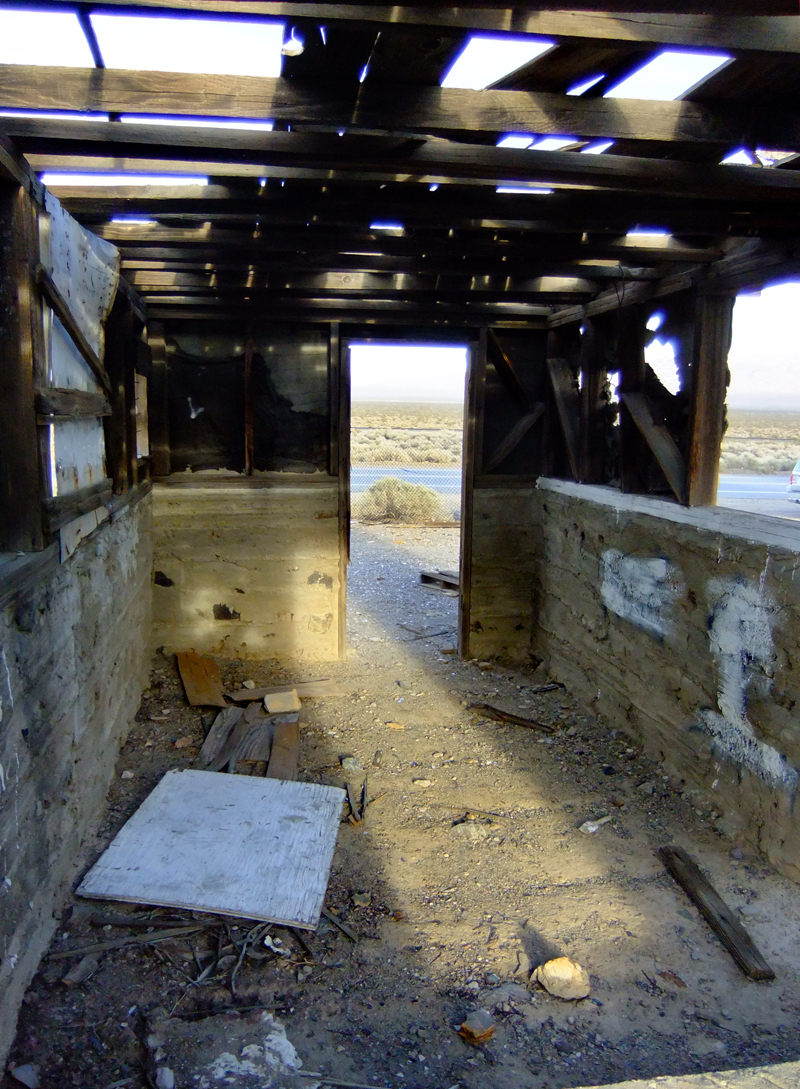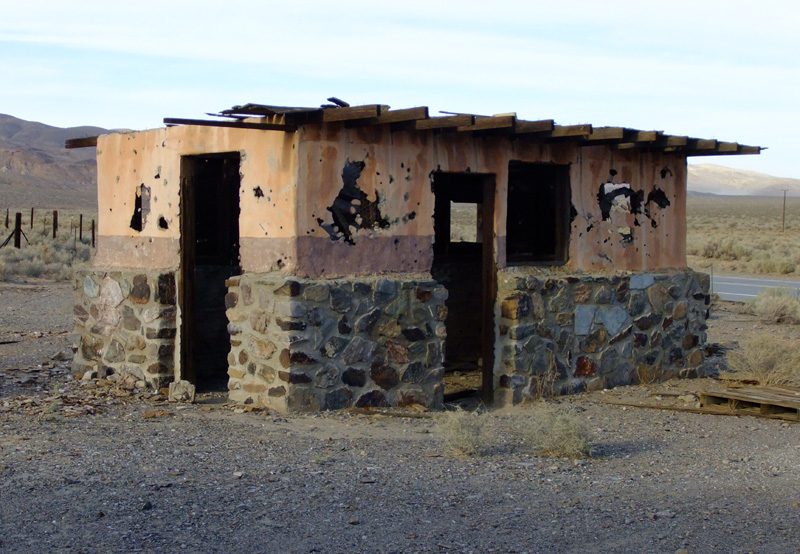|
|
Mojave Desert

Click image to enlarge
April 13, 2013 — Abandoned structure(s) at Garlock. The tiny ghost town of Garlock is located on Garlock Road, just off of the Redrock-Randsburg Road, about 40 miles northeast of Mojave and 7.5 miles west of Highway 395 (see map). For a short time at the turn of the 20th Century, Garlock crushed ore from the Yellow Aster gold mine at Randsburg, nine miles distant. Garlock is California Historic Landmark No. 671. The historic marker, placed at the townsite in 1960, reads as follows: In 1896, Eugene Garlock constructed a stamp mill near this spot to crush gold ore from the Yellow Aster Mine on Rand Mountain. Known originally as Cow Wells by prospectors and freighters during the 1880s and early 1890s, the town of Garlock continued to thrive until 1898, when water was piped from here to Randsburg and the Kramer-Randsburg rail line was completed. Eugene Garlock was a prosperous farmer from Tehachapi. The place in the desert where he erected his stamp mill actually went through several name changes — including Eugeneville, an adaptation of his first name — before his surname won out. The (Bakersfield) Californian of Feb. 16, 1896, described Mr. Garlock's operation but was, in hindsight, a tad bit optimistic of its future: "The new eight stamp mill of Eugene T. Garlock, at Eugeneville, near Goler, under the supervisor of Mr. Lovejoy, the contractor, is rapidly being built. The building proper is 50 x 75, with other additions adjoining. The concentrator and sulphuret rooms are completed and ready to receive their machinery. The large battery blocks are all framed and will be placed in the battery pit in a day or two. The ore bins are about completed and will hold 600 tons. The stamps weigh 900 pounds each, which is a sufficient weight to do good work, in crushing the rock of that district. Mr. Garlock informed your correspondent that he expected to have the mill completed by the first of March. There is not the slightest doubt but what twenty-five more stamps will be added next year, as the Randsburg company alone have enough ore in sight to keep a 100 stamp mill running steadily for the next fifty years. This is a fact. With the completion of the mill, Eugeneville will become one of the best mining camps in the State." Several hundred people are said to have resided in Garlock during its short-lived heyday. By 1903, after a stamp mill was erected at Randsburg, rendering Mr. Garlock's mill all but obsolete, most of them had left. Small amounts of ore continued to be processed at Garlock until 1907, when Eugene Garlock died. Prospectors Frederic M. Mooers, William J. Langdon and B. F. McGee had been placer mining in the El Paso Mountains, east of Red Rock Canyon and south of Ridgecrest, when in 1894 they ventured south to explore the Rand mountains. They found little "color" and went back to the dry wash which had been worked since the 1850s when a German named John Goler discovered significant amounts of gold in what became the Summit Range Mining District. But an especially wet winter in 1894-95 made placer mining impractical, so Mooers returned to the Rand region in 1895 with a new partner, John Singleton, and took a closer look. According to a subsequent report in The (Bakersfield) Californian, the volcanic mountain 40 miles northeast of Mojave was "covered with 'float' showing free gold as large as wheat grains to the naked eye."[1] Mooers, Singleton and a third partner, Charles Burcham, staked their claims April 25, 1895. Originally incorporated as the Rand Mountain Mining Company — named for the Rand Gold Mining District in South Africa — they soon changed the name to Yellow Aster Mining and Milling, from a new novel one of the men was reading at the time ("A Yellow Aster" by Hunt Caffyn, 1894).[2] The Rand Mining District was organized Dec. 20, 1895, out of the Summit Range District. Mooers, Singleton and Burcham sank "a fifteen foot shaft and developed a ledge six feet wide between well-defined walls of prophecy and mica schist," according to the San Francisco Call of Jan. 27, 1896. "They then began prospecting for other ledges and located fourteen other claims." No sooner had they paid their registration fee — with some difficulty — than word got out. The area filled up with hundreds of "prospectors, investors, fortune-seekers, and mining experts from South Africa to the Caribous and the Comstock to the Atlantic," according to the Call, which declared that Randsburg, as the camp was called, would surely become "the loadstone of the mining world." "Over $250,000 has been extracted from the mines of this camp by the original locators within a period of six months," the paper reported. Ore was hauled out by the Searles Borax team to Mojave and shipped to the Selby works in San Francisco, the Call said. By the start of 1896 there were "five wooden buildings, including stables, corral, saloon and about thirty tents." Later that year the nearby supply town of Johannesburg was established. That same year, the prosperous Tehachapi farmer Eugene Garlock constructed a stamp mill at Cow Wells, as the place was known by prospectors and freighters in the 1880s and early 1890s. Renamed Garlock and situated about nine miles west-northwest of Randsburg near today's Redrock-Randsburg Road (which connects Highway 14 on the west with Highway 395 on the east), the location provided water that was carted to Randsburg in 1896 and 1897 at $2 a barrel. By late 1897, under Singleton's superintendency, the Yellow Aster had 65 men on payroll and was leasing at least one of as many as three stamp mills at Garlock (the Visalia Mill).[3] Running day and night, the mill crushed as much as 20 tons of ore daily from the Yellow Aster until 1898, when the Kramer-Randsburg rail line was completed and the ore was hauled to a new 50-stamp mill in Barstow.[4] A 30-stamp mill was also erected in that year at the Yellow Aster, and in 1901 a 100-stamp mill was added on site. The Barstow mill was no longer needed. The Yellow Aster mills used water piped in from Garlock. By this time, according to authors Peter G. Massey and Jeanne Wilson[5], Randsburg's population swelled to 3,500 and the town sported "hotels, saloons, a general store, an Orpheus theater and even a brass band." The Yellow Aster operated nearly continuously from 1895 to 1918 and reopened in 1921. In 1933 the Anglo American Mining Corp. Ltd. leased it and operated it until 1939. There have been intermittent lessees since that time. According to reports from the California Division of Mines and Geology, the Yellow Aster's rich, gold-bearing placer was initially worked in dry washers in 1895. After the easy pickings were depleted, "mining was conducted underground and by 1905 about seven and one half miles of horizontal underground working had been driven. Most of the ore mined from 1905 to 1933 was obtained from a large glory hole, but underground mining was continued and, by 1909, workings totaled between 12 and 15 miles in length." In 1934 a sand and slime cyanide plant was built to treat 1,100 daily tons of both old and current stamp-mill tailings. "Between 1895 and 1939, more than 3,400,000 tons of ore was milled, and about 500,000 ounces of gold was recovered, nearly all by amalgamation. In addition, 1,700,000 tons of mill tailings was treated and yielded 41,000 ounces of gold." As stated, mining was nearly continual in the early years. Although there were other mining concerns in the area, the Yellow Aster was the big dog, and the laborers wanted to share in its success. In September 1902 the Federation of Miners union of Randsburg demanded that the car men and shovelers (top-siders), who earned $2.50 per day, be paid the same wage as the underground miners, who earned $3. Singleton resisted, and by June 1903 the union was demanding $3.50 for the miners and $3 for the muckers. On June 10 they voted to walk out — not only from the Yellow Aster but also from several other mines in Kern County. The Yellow Aster shut down rather than concede to the union. "Because of the miners' strike at Randsburg all business is at a standstill and merchants are giving no credit. The camp is practically dead," the San Francisco Call reported. Strike-busting was illegal under state law, but the Yellow Aster did it anyway. John D. Ackerman, the company's attorney and agent in San Francisco, recruited non-union miners from Missouri and elsewhere, and in mid-September mining resumed with 60 new employees. In solidarity with the union, the mayor shut the saloons. By early October, the Yellow Aster was fully operational with roughly 200 men. Ackerman went into hiding and ultimately surrendered to authorities, but the charges were dismissed in June 1904 when the three witnesses for the prosecution failed to appear in court. The Yellow Aster didn't increase wages during this period; ironically, they were already above average. They were reported in January 1904 as follows: "Miners nine hours $3.00; muckers 9 hours $2.50; car men 9 hours, $3.00; timber men 9 hours $3.50; amalgamators 12 hours $4.00; stationary engineers 12 hours $4.00; hoisting engineers 8 hours $3.50; and the pump men 12 hours $3.50." At the time, the Yellow Aster consisted of the following individual mines: Alameda, Big Horse, Burcham #1, Burcham #2, California, Columbia, Defender, Desert View, El Rico, Fannie C., Golden Queen, J. B., Johannesburg, Mariposa, Mooers, Nancy Hanks, North End, Old Dollar, Olympus, Prescott, Rand, Reservoir, Wedge, Scott, Security, Singleton, Tennessee and Trilby Wedge. Gold production tapered off after the 1930s but didn't stop entirely. It continued through the 1960s and still occurs intermittently on a small scale. The lucrative Kelly Silver Mine, aka California Rand Silver Mine, was discovered in 1919 and was worked on a major scale through the 1930s. Tungsten, a strategic material, was mined during the first and second world wars. Today Randsburg bills itself as a "living ghost town" with numerous antique shops, a museum, bar, and plentiful accommodations for off-road enthusiasts.
1. Most newspaper citations used herein are found at the nonprofit Rand Desert Museum's website. 2. Turnabout being fair play, in 1913, Wallace Reed ("Birth of a Nation") would star in the film, "The Mystery of Yellow Aster Mine" by Frank Borzage ("A Farewell to Arms"). 3. According to The Los Angeles Daily Times of May 20, 1898, there were three stamp mills at Garlock: the Henry, the Garlock and the Visalia. 4. The Garlock mills continued to process small quantities of ore until Eugene Garlock's death in December 1907. 5. "Backcountry Adventures Southern California," Adler Publishing Co. 2002. Third printing 2006. LW2366i: 9600 dpi jpeg from digital image by Leon Worden. |
The site owner makes no assertions as to ownership of any original copyrights to digitized images. However, these images are intended for Personal or Research use only. Any other kind of use, including but not limited to commercial or scholarly publication in any medium or format, public exhibition, or use online or in a web site, may be subject to additional restrictions including but not limited to the copyrights held by parties other than the site owner. USERS ARE SOLELY RESPONSIBLE for determining the existence of such rights and for obtaining any permissions and/or paying associated fees necessary for the proposed use.



















